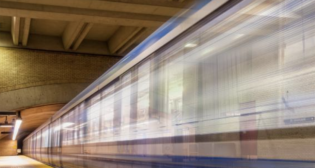
VIA Rail Adventures (Second of a Series)
Written by David Peter Alan, Contributing EditorVIA Rail has only two routes that it calls “long-distance” trains, and together they offer only five departures per week, not enough to add up to a single daily departure. One is the Canadian between Toronto and Vancouver, and the other is the Ocean between Montreal and Halifax. The former wends its way through northern Ontario and points west on a four-day journey (it used to take three days) twice a week, while the latter takes about 24 hours from end to end, depending on how late it runs. The endpoints for those trains are separated by five to six hours of travel time, covered by the railroad’s second-busiest corridor, although its level of service does not come close to the busiest on Amtrak.
For very different reasons, each of those trains turned out to be “two trains in one” and both situations felt strange. One felt somewhat disquieting and will be covered in more detail at the conclusion of this series. That was the Ocean to Halifax, and I will report on that later. First I rode west from Toronto.
A Journey West, But Not All the Way
I needed to use the Canadian to get from Toronto to Winnipeg, as there are no rail connections from the United States, except at the train’s endpoint cities. There are no buses, either. From Winnipeg, I could begin the long and circuitous route to Churchill. I had ridden the Canadian before, the last time was before the COVID-19 virus hit. I rode in a sleeping car on that trip, in a lower berth, which was spacious and comfortable. There was delicious food in the dining car, and plenty of activities in the lounge cars (plural), including the observation car (VIA Rail calls it a “Park car”) at the rear of the train. That car and the lounge cars (called “Skyline cars”) had domes. The train was a museum of sorts, replicating the experience of rail travel from a bygone era on equipment now almost 70 years old, in effect, a “luxury train” like the ones of the past, which ran less than daily.
The fleet was built by the Budd Company for Canadian Pacific in 1954. It was the equipment for the original Canadian train on CP Rail, which lasted into the VIA Rail era and ran for the last time early in 1990. The name continues, but the route does not. It now runs on CN track all the way, except for a relatively short distance from Vancouver eastward and another through Parry Sound, Ontario on the way west. So, in effect, the train is named for its original equipment instead of its original route.
My journey this time was nothing like the one I had experienced in the sleeping car. Since that time, the train had suffered badly as the pandemic raged, discontinued for some time and, at first, returning to operate only once a week with restrictions on where passengers could go. The twice-a-week schedule is back, but the amenities are not, at least not for coach passengers in “economy” class.
The part of the route between Toronto and Winnipeg is not unpleasant, but it is not scenic, either. The great scenery is west of Edmonton, Alberta, and most of it is in British Columbia. That is the part of the route where riders can look out the window and view the majesty of the Canadian Rockies and follow rivers like the Fraser and the Thompson (if the train to Vancouver is sufficiently late). The eastern portion of the route runs along the Canadian Shield, an apparently limitless expanse of lakes and woods, nearly two days of them. There are no cities between Toronto and Winnipeg, and not even many towns. The train runs far north of Lake Superior. It was the CP main, which last saw a scheduled passenger train in 1990, that called at bigger towns in Ontario like Sudbury, Thunder Bay, and Kenora.
Highlights on that trip were few and far-between, quite literally. There were plenty of flag stops at settlements in remote areas, some at stations that are now boarded-up, although a few soldier on as town museums. Some stops are so remote that they are far from any human habitation. On the trip, a group of five adventurers from Minnesota got off the train at MP 24.5, railroad west from Armstrong, Ontario. They had stored their canoes and other outdoor gear in the baggage car, and they were going to a remote lake for some outdoor summer fun. They said they had a way to return to civilization at Thunder Bay, but it was difficult to fathom how. It was also amazing that they managed to get off the train with all their gear, including two canoes, because the ballast under my feet felt like it was forming a 30-degree angle downward from the horizontal, and I had no intention of letting go of the grab iron on the door frame as I watched the adventurers get off. Still, they did it with help from the train crew.
Riding in “Steerage”
A casual observer viewing a picture of the train’s consist would not notice the class-based segregation inside that was at least as prejudicial as anything similar ever practiced on Amtrak, including today’s policy that prohibits coach passengers from eating in the dining cars on a number of Amtrak trains.
A description of the consist will help explain this. Not counting a crew car and separate baggage cars serving coach and sleeping-car passengers, the small coach section (“economy class” in VIA Rail’s parlance) was located just behind the locomotives. The rest of the train, all the way back to the “Park” observation car at the rear, was reserved for sleeping car passengers only. There were absolutely no exceptions allowed. There were ten sleeping cars on the train, supported by three “Skyline” dome-lounge cars and two full dining cars, along with the observation car. Crew members provide entertainment and educational presentations to passengers in the sleeping cars, who are also treated to meals freshly prepared by chefs.
No coach passenger was permitted to partake of any of this. Our portion of the train consisted of two coaches, which were comfortable, in the best tradition of the “Streamliner” equipment of its era. Coach passengers also had access to a “Skyline car” of their (our) own. That class of car has a small lounge section at one end and six dining tables at the other. Between them, seven steps up, is the dome, the invention and pride of the Budd Company, which built the cars. Under the dome, two steps down from the level of the lounge and dining sections, was a space for the attendant, who sold snacks and beverages. There was also a small kitchen with commercial-grade appliances, which once housed a cook who prepared meals for coach passengers during the train’s better days. Those meals were not elaborate, but they were cooked on board, and they weren’t bad. On the trip I took and probably on all trips, that kitchen sat forlorn and empty, as did the six dining tables on the other side of the dome.
One of my fellow passengers remarked that we were “riding in steerage,” a reference to the lowest class of service on the old ocean-going passenger ships that brought immigrants to the United States and Canada in bygone days. There was a difference, though. On the big ships, even passengers who paid “economy” fares got freshly prepared food to eat during the voyage, even if it was plain.
BYOF (Bring Your Own Food)
If I can offer one piece of advice for anybody who plans to take a long ride on VIA Rail, that is my most-important suggestion. There is no alternative available on the train and, unlike Amtrak trains, the Canadian does not make any stops where it is possible to jump off and get something to eat during the train’s standing time. The only chance for that on the four-day trip between Toronto and Vancouver might be at Winnipeg, the only downtown station in a city between those endpoints. That local eatery is a hot dog and hamburger joint called V.J.’s Drive Inn, located on Main Street, about one block from the station. It is strictly a take-out place, although there are picnic tables available, at least in season (Winnipeg is known for its brutal winters). I had a burger there, and it was great, but I did that on a day I was spending in town, anyway, so I was not extra-hungry from being on the train. If you get to Winnipeg too late or if the weather is too cold, you could be out of luck and stuck with what VIA Rail now offers, maybe for two more days.
When Amtrak and VIA Rail jointly offered the North America Rail Pass in the 1990s and until 2009, I rode many of VIA Rail’s trains, but not the “Adventure routes” that comprised my recent itineraries. At that time, there was a cook preparing food for coach passengers, which they could eat at the six tables in the Skyline car. It was even possible, if the dining cars were not too busy, for coach passengers to purchase meals. When I rode back then, I spent most of my time with my fellow coach passengers and took a leisurely (and sometimes long) walk to a dining car, where I ate mostly with the sleeping-car passengers. There were some Canadians and Americans, but many of the sleeping car passengers in those days were British, enjoying a “land cruise” by rail through a large and uncrowded country.
It was a thoroughly enjoyable travel experience, but it is no longer available, because of the class-based segregation. Coach passengers are “confined to quarters” and are offered only microwaved snacks and sandwiches, with a few lounge car offerings like those on Amtrak, for the entire trip. I sampled one of the meals, a small portion of chicken and rice that for me was barely edible. The following day, my only chance to eat was an opportunity to dash into a convenience store in Sioux Lookout to buy a pre-made sandwich that was not very good, but it was better than what VIA Rail had.
It does not seem necessary to enforce such rigid class segregation. I have ridden hundreds of thousands of miles on Amtrak, and even on VIA Rail when such “mixing” was allowed. I almost always rode in coach and spent the money I saved enjoying meals, activities and accommodations at my destinations. Never once had I been treated with any condescension or disrespect because of the car in which I rode. I only got that from the crew on VIA Rail. Today, Amtrak allows a few coach passengers to purchase meals on some trains with dining cars, but VIA Rail does not allow that at all.
When I boarded at Toronto, I learned that the passenger count was 150 in the ten sleeping cars and 78 in the two coaches. So the coaches were relatively crowded (including some passengers who were taking short trips), while the sleeping cars were not nearly full (each holds 22 passengers, except for the ones converted to staterooms for “Prestige” Class). Two dining cars, even with 11 tables instead of 12, could accommodate 176 passengers at two sittings, more than the number of sleeping car passengers. A third sitting could have accommodated everybody in coach, and certainly the number of coach riders who would have liked to eat there. It also would have increased the revenue on a train that, clearly, was operating under the weight of high overhead.
Nonetheless, that was the policy, and as I left Churchill, I had begun to lose weight due to the lack of food on VIA Rail. But I’m getting ahead of my story. After a Monday night in Winnipeg, it was time to take the journey north to Churchill. The isolation of both the route and the destination provide the conditions for a unique travel experience, which I will describe in the next article in this series.

David Peter Alan is one of America’s most experienced transit users and advocates, having ridden every rail transit line in the U.S., and most Canadian systems. He has also ridden the entire Amtrak and VIA Rail network. His advocacy on the national scene focuses on the Rail Users’ Network (RUN), where he has been a Board member since 2005. Locally in New Jersey, he served as Chair of the Lackawanna Coalition for 21 years, and remains a member. He is also Chair of NJ Transit’s Senior Citizens and Disabled Residents Transportation Advisory Committee (SCDRTAC). When not writing or traveling, he practices law in the fields of Intellectual Property (Patents, Trademarks and Copyright) and business law. Opinions expressed here are his own.



